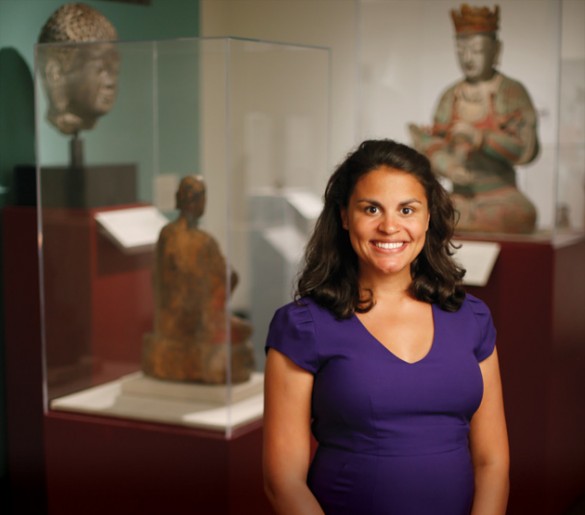
University students are bombarded with dozens of media images each day. Rebecca VanDiver’s goal is to get them not only thinking critically about what they see, but doing so with trained eyes.
“I think art history provides a space in which you can hone those critical viewing skills in conjunction with developing really high-level analytical and writing skills in a unique way,” she said. VanDiver’s research focuses on African American artistic production in the 20th and 21st centuries—specifically, how African American artists have negotiated ideas of Africa in their works.
“I view art history as a unique discipline in that we get to use visual objects to study culture and society,” she said. “I came to study African American art history in part because I was curious about how African Americans were being represented in the larger canon of American art, and how African American artists were responding to their place within society vis-à-vis their artistic production.”
VanDiver, a native of Maine, initially pursued a government major at Harvard University thinking she would put her language skills to use with a career in the foreign service. But needing to complete a humanities requirement, she signed up for an art history class on a whim. “My eyes were opened to all the possibilities art history afforded,” she said. “[rquote]I loved the different ways you could approach a single work—from an economic point of view, from a social or cultural perspective, from a strictly formal one.[/rquote] I was hooked.”
In the course of earning her master’s and Ph.D. from Duke University, VanDiver completed a two-year predoctoral fellowship at the University of Virginia’s Carter G. Woodson Institute for African-American and African Studies. She came to Vanderbilt in 2013 as a senior lecturer and began her tenure track as assistant professor of history of art this fall.
Since art can be experienced with all the senses, it’s important to have direct access to objects whenever possible, she said. The Vanderbilt Fine Arts Gallery has a solid collection of African American works, particularly prints, by artists including Jacob Lawrence, Romare Bearden and Kara Walker. A valuable resource also exists in nearby Fisk University, which has one of the strongest African American studio arts programs dating back to the 1940s, when it was founded by painter Aaron Douglas, a major figure of the Harlem Renaissance.
VanDiver is currently working on a book about Loïs Mailou Jones, another Harlem Renaissance painter and longtime Howard University professor whose career spanned the 1920s to the 1990s. “I use her as a case study to explore how ideas of Africa shifted in the African American consciousness through art over the course of the 20th century,” she explained.
VanDiver’s classes incorporate a variety of mediums—everything from painting, sculpture and photography to Michael Jackson videos and Beyoncé’s latest Grammys performance. “I see myself as a scholar who bridges the gap between the rubric of more traditional fine art and contemporary visual and material culture,” she said.
View the complete list of new university faculty for 2014-15.
View the complete list of new medical faculty for 2014.